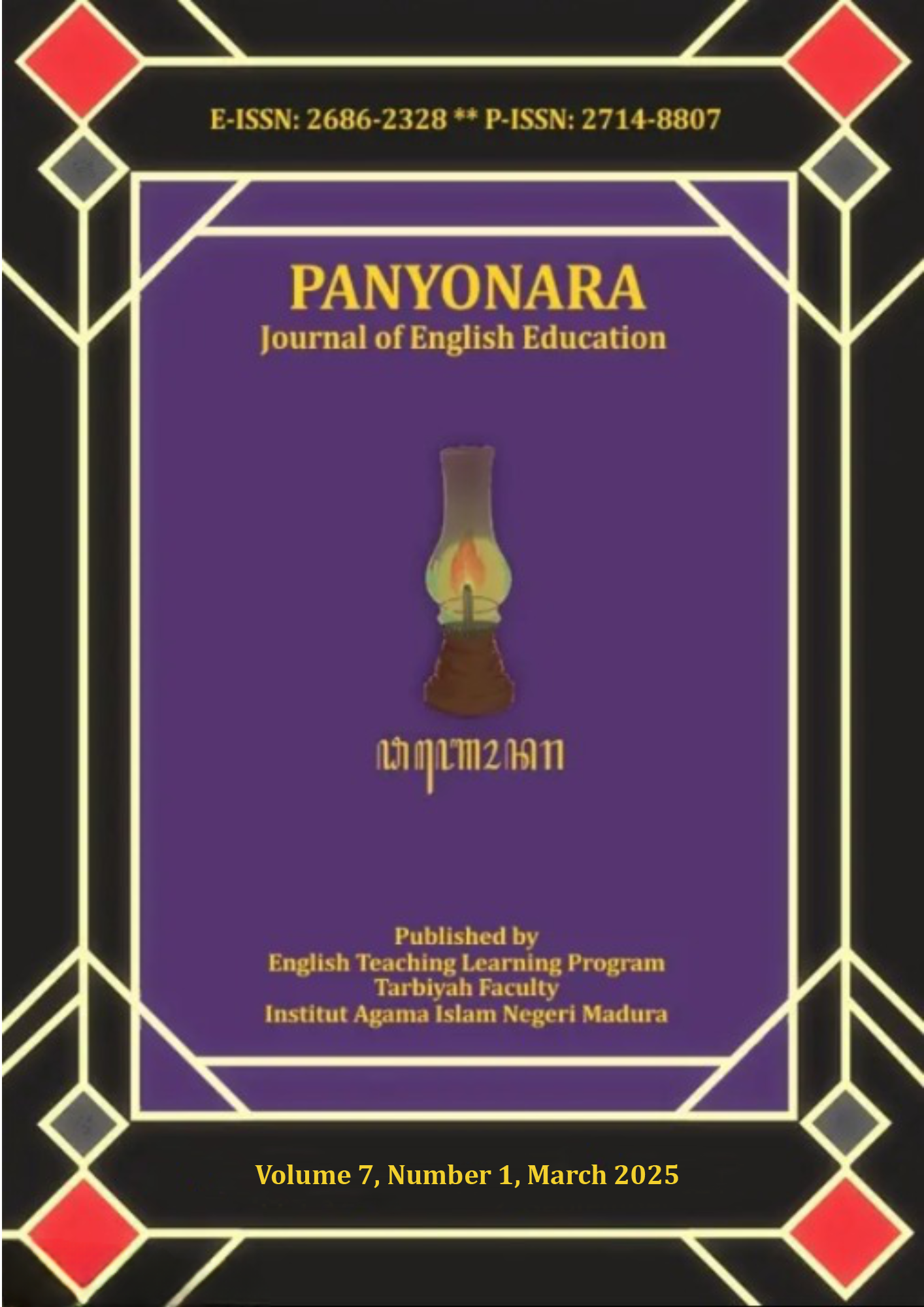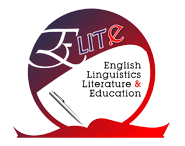Unveiling English Speaking Competence: A Portrait of First-Semester Students in the Foreign Language Development Program
 Abstract views: 39
,
Abstract views: 39
,
 PDF downloads: 20
PDF downloads: 20
Abstract
This research delves into the English-speaking competence of first-semester students enrolled in the Foreign Language Development Program (FLDP) at IAIN Madura. Through a survey of 279 students across four faculties, the study investigates the current state of English-speaking proficiency and identifies factors influencing it. The findings reveal that a majority of students self-rate their speaking skills as basic, with limitations in vocabulary, pronunciation, and confidence hindering their fluency. This highlights the need for targeted interventions, including increased speaking practice, vocabulary instruction, and a supportive classroom environment to enhance students' English-speaking competence and prepare them for academic and professional communication in a globalized world. The study identifies key factors influencing speaking fluency, including lack of self-confidence, low motivation, and limited prior exposure to English. It emphasizes the importance of addressing these factors through effective language instruction, incorporating task-based learning, communicative approaches, and providing adequate institutional support. The research underscores the need for a comprehensive approach to language instruction that prioritizes increased speaking practice, vocabulary instruction, and a supportive classroom environment to improve students' English-speaking competence and prepare them for the demands of academic and professional communication in a globalized world.
Downloads
References
Alqahtani, M. (2015). The importance of vocabulary in language learning and how to be taught. International Journal of Teaching and Education, III(3), 21–34. https://doi.org/10.20472/TE.2015.3.3.002
Anggrisia, N. F., & Robah, A. (2023). Exploring challenges and strategies in English speaking among Indonesian university students: A case study of AKM university. Englisia: Journal of Language, Education, and Humanities, 11(1). https://doi.org/10.22373/ej.v11i1.19156
Anita, Hidayani, S., Nuraeni Silfani, A., & Razali, K. (2023). Pragmatic Approach In Teaching Speaking Skills for Vocational High School Students. Loquen: English Studies Journal, 16(1), 67–74. https://doi.org/10.32678/loquen.v16i1.8762
Aziez, F., Estiningsih, E., & Sofiana, I. (2022). An Analysis of University English Students’ Vocabulary Development. Khazanah Pendidikan, 16(2), 60. https://doi.org/10.30595/jkp.v16i2.13788
Boy Jon, R., Embong, R., Purnama, B., & Safar Wadi, A. (2021). The Challenges of English Language Teaching in Indonesia. International Journal of English and Applied Linguistics (IJEAL), 1(3), 158–168. https://doi.org/10.47709/ijeal.v1i3.1157
Brown, H. D. (2006). Language assessment: Principles and classroom practices (Nachdr.). Longman.
Burns, A., & Richards, J. C. (2018). The Cambridge Guide To Learning English As A Second Language. Cambridge University Press. https://pdfcoffee.com/qdownload/anne-burns-jack-c-richards-cambridge-guide-to-pdf-free.html
Chima Abimbola Eden, Onyebuchi Nneamaka Chisom, & Idowu Sulaimon Adeniyi. (2024). Cultural Competence in Education: Strategies for Fostering Inclusivity and Diversity Awareness. International Journal of Applied Research in Social Sciences, 6(3), 383–392. https://doi.org/10.51594/ijarss.v6i3.895
Córdoba Zúñiga, E. (2016). Implementing Task-Based Language Teaching to Integrate Language Skills in an EFL Program at a Colombian University. PROFILE Issues in Teachers’ Professional Development, 18(2), 13. https://doi.org/10.15446/profile.v18n2.49754
Daymiel, R. J., Cantina, J., Alipoyo, V. R. I., Comecilla, M. O., Patay, A. S., & Recamara, J. T. (2022). Anxiety in Second Language in Relation to Students’ Speaking Performance. Sprin Journal of Arts, Humanities and Social Sciences, 396–410. https://doi.org/10.55559/sjahss.v1i08.41
Devi, A. P. (2023). Relationship between English Proficiency and Academic Achievement of Indonesian EFL Postgraduate Students. Journal of English Language Learning, 7(1), 303–308. https://doi.org/10.31949/jell.v7i1.5566
Febrianingrum, L., & Rabbianty, E. N. (2022). The Power of Integrating Bite-Sized Learning and Teacher Talk on Telegram Amid Pandemic. OKARA: Jurnal Bahasa Dan Sastra, 16(1), 129–145. https://doi.org/10.19105/ojbs.v16i1.5844
Ghafar, Z. N., & Raheem, B. R. (2023). Factors Affecting Speaking Proficiency in English Language Learning: A general overview of the speaking skill. Journal of Social Science (JoSS), 2(6), 507–518. https://doi.org/10.57185/joss.v2i6.107
Ghufron, M. A., Taufiq, A., & Firdaus, A. U. (2024). Intercultural Dynamics in English Language Learning at Islamic Schools: Impacts on Student Islamic Identity Construction in a Culturally Pluralistic Context. Jurnal Pendidikan Bahasa Inggris Undiksha, 12(2), 230–240. https://doi.org/10.23887/jpbi.v12i2.85011
Goodman, B., Kambatyrova, A., Aitzhanova, K., Kerimkulova, S., & Chsherbakov, A. (2022). Institutional Supports for Language Development through English‐Medium Instruction: A Factor Analysis. TESOL Quarterly, 56(2), 713–749. https://doi.org/10.1002/tesq.3090
Hadianti, S., & Arisandi, B. (2020). Pushing toward internationalization of higher education: Challenges for a newcomer. In U. Kusmawan, S. Aisyah, I. Rokhiyah, Andayani, D. Raymena Jovanka, & D. Sukmayadi (Eds.), Emerging Perspectives and Trends in Innovative Technology for Quality Education 4.0 (1st ed., pp. 128–131). Routledge. https://doi.org/10.1201/9780429289989-36
Halim, A., Atikah, D., Rezki, A., Nurul Fadillah, F., & Astuti, D. (2022). Student Reflections on Intercultural Communicative Competence: A Case Study of EFL Islamic Higher Education Students in Kendari. KnE Social Sciences, 351–356. https://doi.org/10.18502/kss.v7i8.10754
Hanzawa, K. (2024). Development of second language speech fluency in foreign language classrooms: A longitudinal study. Language Teaching Research, 28(3), 816–838. https://doi.org/10.1177/13621688211008693
Harmawati, F., Ilma, R., & Amrina, R. D. (2024). Voices Unheard: Teachers’ Perspectives on Students’ Speaking Challenges in the Classroom. The Art of Teaching English as a Foreign Language (TATEFL), 5(2), 175–185. https://doi.org/10.36663/tatefl.v5i2.895
Hidayati, T. (2017). English Language Teaching in Islamic Education in Indonesia; Challenges and Opportunities. Englisia Journal, 3(2), 65. https://doi.org/10.22373/ej.v3i2.751
Hiver, P., Al-Hoorie, A. H., Vitta, J. P., & Wu, J. (2024). Engagement in language learning: A systematic review of 20 years of research methods and definitions. Language Teaching Research, 28(1), 201–230. https://doi.org/10.1177/13621688211001289
Huang, B., & Luo, J. (2024). The Linguistic Challenge of the Transition to Secondary School: A Corpus Study of Academic Language by Alice Deignan, Duygu Candarli, and Florence Oxley. Corpus-Based Studies across Humanities, 1(1), 273–277. https://doi.org/10.1515/csh-2023-0021
Ismajli, E. (2024). Navigating the Development of English Language Skills in Higher Education. Uluslararası Özel Amaçlar Için İngilizce Dergisi. https://doi.org/10.70870/joinesp.1594239
Lightbown, P. M., & Spada, N. (2013). How Languages are Learned? (4th ed.). Oxford University Press. https://s1.papyruspub.com/files/demos/products/ebooks/academicbooks/applied-linguistics/Preview-How-Languages-are-Learned-by-Lightbown-and-Patsy-M.pdf
Maji, E., Samanhudi, U., & Mokoagouw, M. E. (2022). Students’ Difficulties in Speaking English: (A Case Studin SMKN 3 Sorong). 5(1), 95–109. https://doi.org/10.32531/jsoscied.v5i1.416
Mandasari, B., Rahmah, M., & Mukminatien, N. (2024). Developing an Assessment Instrument Model for Indonesian Cultural-based Oral Presentation for Undergraduate EFL Students. Journal for Foreign Languages, 16(1), 385–402. https://doi.org/10.4312/vestnik.16.385-402
Marpaung, N. R. (2023). English Speaking Anxiety Among Junior High School Students: Unveiling Causes and Solutions. TELL-US JOURNAL, 9(1), 146–163. https://doi.org/10.22202/tus.2023.v9i1.6678
Masruddin, M., & Zuljalal Al Hamdany, M. (2023). Students’ Motivation in Learning English in Islamic Higher Education. FOSTER: Journal of English Language Teaching, 4(4), 199–207. https://doi.org/10.24256/foster-jelt.v4i4.147
McLaren, I. (2019). Science Students’ Responses to an Oral Communication Skills Development Initiative: Attitude and Motivation. International Journal of Teaching and Learning in Higher Education, 31(1), 73–85.
Milton, J., & Hopwood, O. (2022). Vocabulary in the Foreign Language Curriculum: Principles for Effective Instruction (1st ed.). Routledge. https://doi.org/10.4324/9781003278771
Minda, S. (2023). Factors Influencing The Students’ Speaking Ability. Lingua, 19(2), 227–239. https://doi.org/10.34005/lingua.v19i2.3137
Nguyen Thi Thu, H. (2022). Pschological Factors Affecting English Speaking Skills Among Vietnamese Students. Journal of Science Social Science, 67(4), 153–162. https://doi.org/10.18173/2354-1067.2022-0070
Noviyanti, S. D. (2024). Intercultural Communicative Competence Based Learning Model For Teaching Efl In Islamic Higher Education In 21st Century. 4. https://doi.org/10.24090/celti.2024.1021
Pun, J. (2024). Effects of Prior English Exposure on Hong Kong Tertiary Science Students’ Experiences in EMI Learning. RELC Journal, 55(1), 144–161. https://doi.org/10.1177/00336882221079057
Purwanto, M. B., Yuliana, Y., Soleimani, H., & Yusri, Y. (2024). Psychological traits of willingness to communicate: An assessment of students’ speaking performance. Jurnal CULTURE (Culture, Language, and Literature Review), 11(2), 55–65. https://doi.org/10.53873/culture.v11i2.635
Rahmawati, F. (2020). The undergraduate students’ beliefs about English language learning; a survey study in Madurese context. Leksika: Jurnal Bahasa, Sastra Dan Pengajarannya, 14(2), 60. https://doi.org/10.30595/lks.v14i2.7637
Ramadan Elbaioumi Shaddad, A., & Jember, B. (2024). A step toward effective language learning: An insight into the impacts of feedback-supported tasks and peer-work activities on learners’ engagement, self-esteem, and language growth. Asian-Pacific Journal of Second and Foreign Language Education, 9(1), 39. https://doi.org/10.1186/s40862-024-00261-5
Saefurrohman, Balinas, E. S., Rosadi, A., Nafisah, S. L., & Pascarina, H. (2024). Innovative Approaches to English Language Teaching in Indonesian Public Islamic Schools: Insights and Challenges. Script Journal: Journal of Linguistics and English Teaching, 9(1), 42–57. https://doi.org/10.24903/sj.v9i1.1611
Srivinas Rao, P. (2019). The Importance of Speaking Skills in English Classrooms. Alford Council of International English & Literature Journal (ACIELJ), 2(2), 6–18.
Sumanto, O. B. T., & Saharani, A. A. (2023). The EFL Students’ Perspective of Their Speaking Competence and Self-Confidence: A Qualitative Study. Indonesian Journal of Multidisciplinary Educational Research, 1(1), 1–13. https://doi.org/10.30762/ijomer.v1i1.1120
Tan, C. (1970). Educative Tradition and Islamic Schools in Indonesia. Journal of Arabic and Islamic Studies, 14, 47–62. https://doi.org/10.5617/jais.4638
Wafi, A. (2019). Using Games to Improve Students’ Active Involvement in the Learning of English Syntax at IAIN Madura: An Autonomous Learning. OKARA: Jurnal Bahasa Dan Sastra, 13(1), 107. https://doi.org/10.19105/ojbs.v13i1.2256
Wei, B., Dipolog-Ubanan, G. F., Khodi, A., & Qu, Y. (2024). The Effect of Learning Strategy and Self-Efficacy on Speaking Competence of Higher Vocational College Students: Anxiety as a Mediator. Educational Administration: Theory and Practice. https://doi.org/10.53555/kuey.v30i5.4194
The journal uses an Open Access policy under a Creative Commons Attribution-NonCommercial 4.0 International License. Authors who publish with this journal agree to the following terms:
- Authors retain copyright and grant the journal right of first publication with the work simultaneously licensed under a Creative Commons Attribution License that allows others to share the work with an acknowledgment of the work's authorship and initial publication in this journal.
- Authors are able to enter into separate, additional contractual arrangements for the non-exclusive distribution of the journal's published version of the work (e.g., post it to an institutional repository or publish it in a book), with an acknowledgment of its initial publication in this journal.
- Authors are permitted and encouraged to post their work online (e.g., in institutional repositories or on their website) prior to and during the submission process, as it can lead to productive exchanges, as well as earlier and greater citation of published work.
















